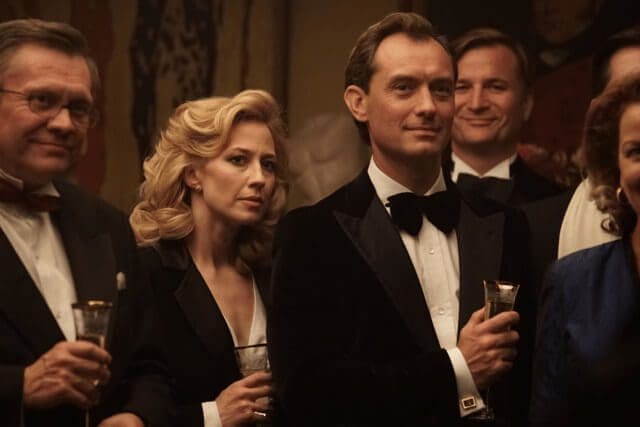There’s a scene near the end of The Nest, Sean Durkin’s follow-up (finally) to 2011’s Marcy Martha May Marlene, in which Carrie Coon dances. She has been suffering through a business dinner in which her husband, a British commodities trader named Rory (Jude Law), is preening on about London’s theater scene to impress some clients: Anthony Hopkins is going to be at the National Theater, they simply must go see him, he’ll get them tickets. His wife — her name is Allison — snort-laughs and calls his bluff. She excuses herself to go to the powder room. Then Allison slips out of the posh restaurant and wanders into a nightclub down the street. She downs a vodka tonic. Then she downs another. Suddenly we cut to her on the dance floor, the Communards cover of “Don’t Leave Me This Way” blaring out of the speakers, and Allison is lost in her own private, violent reverie, moving way too intensely to the beat. She’s throwing her hands up, running in place, strutting in circles, closing her eyes and tiling her head back. A few folks next to her move out of her way. The woman has claimed this space for her own.
The whole thing lasts for less than a minute, though it’s one of those sequences — which, like a lot of things in Durkin’s sophomore movie, feels narrative elliptical yet somehow essential to the overall mood — that sticks with you. Partially because it reminds you what an uninhibited physical performer The Leftovers star is, as she turns this sloshed disco boogie into her own personal Martha Graham tribute, and partially because it feels as instantly memorable as it is meme-worthy. (We can now retire “Dance like no one’s watching” for “Dance like you’re a contempt-filled Carrie Coon.”) But mostly because, for the preceding 90 minutes or so, we’ve been waiting for her to let loose. As one half of a couple on the brink of implosion, Coon has silently death-stared, shouted, snarled, snarled and snapped at Law, who gives as much as he gets. But she hasn’t really had the chance to explode, so when she starts swaying back and forth in the club like she’s caught in a storm, it’s the moment of catharsis she — and we — desperately need. The Nest is one long, edge-of-excruciating exercise in domestic tension. Welcome to its one brief, belated moment of release. (The movie opens in theaters this weekend, and on VOD starting November 17th. See it with someone you loathe.)
Set right in the middle of Reagan’s second term and well into the go-go 1980s, this curdled tale of upward mobility run amuck, and eventually run aground, begin in one of the tonier suburbs of upstate New York. An ex-pat who’s chased and caught the American Dream, Rory is living the life of Riley. Their house is a tasteful tribute to wealth. There are two cars in their garage and — remember, this is the mid-’80s — an espresso machine in their kitchen. Allison has a lucrative business training horses and offering riding lessons. Her daughter Samantha (Oona Roche), from a previous marriage, is a gymnast. The couple’s 10-year-old son, Ben (Charlie Shotwell), likes to play soccer with Dad out back by their pool, even when his father cheats in scoring goals. Everything seems perfect. So of course Rory announces that they have to move.
Even though, per Allison, this would be the fourth time they’ve uprooted themselves in the past decade, Rory says he’s got an opportunity back in London with his old firm that’s too good to pass up. He wants to follow the money there before it runs out here. That’s the idea, at least. Once the family arrives in the U.K., they discover Dad has bought them a massive country estate in Surrey. It’s a dark, drafty and forbidding, this new place … but on the plus side, Led Zeppelin once stayed here and recorded an album! Rory’s also bought everyone extravagant gifts, started constructing a personal stable for Allison on the property (along with what could be the single most symbolic horse ever committed to 35mm celluloid) and insists on picking up the bill during expensive lunches. “In America, everybody believes they can be anything,” he tells his colleagues. “Here, you have to settle for the station you’re born into.” That may be a hint as to why Rory really wanted to come back; maybe it’s an “opportunity” to prove that he’s of a higher class than people thought. Meanwhile, his family is not adjusting well to the new surroundings. In fact, they all seem to be falling apart ….
In interviews around The Nest‘s premiere at Sun-dance earlier this year, Durkin mentioned that he’d moved between the U.S. and England as a kid, and he was interested in exploring the differences between the countries. And while it’s easy to imagine that he added autobiographical elements to one or both of the dislocated kids here — Samantha acts out by sneaking cigs and throwing a party in their cavernous digs; a bullied Ben retreats into sullen silence — whatever interest the film has in geographical or cultural differences ended up taking a backseat. All the better, my dears, to let you have a ringside seat for the combatants at the center of the story. Law has always been great at weaponizing his golden-boy looks and charm in everything from The Talented Mr. Ripley to The Young/New Pope, and you can see how his continental bluster probably lubed his success in America but no longer cuts the mustard back home. As for Coon, she of the immaculate slowly crumbling facial expressions — some of the film’s best shots involve the actor just letting the life slowly drain of her eyes and half-smile — her Allison is smart enough to stash money yet steely enough to not back down from a fight. And more than sex and lying to each other, fighting is what these two do best. “You’re embarrassing,” he says to her, right before she tastes a fine wine they can’t afford by grabbing it from the waiter and slugging from the bottle. “And you’re exhausting,” she replies. This is just the under-card-bout.
Law and Coon aren’t the only reason to see Durkin’s marital nightmare of a movie, but they are the main reason to see it, and both of them give these characters so much shared history communicated without saying a word, as well as by the ways they spit cruel words to each other. And along with this cutting, jabbing couple and their lost-and-delirious kids, there is also the fifth character of the nest itself. Durkin is part of a generation of filmmakers clearly weaned on Stanley Kubrick, and part of even smaller subset who feel free to borrow bits of his technique without necessarily imitating him outright. There are enough slow zooms, creeping shots and people tellingly framed in doorways and hallways courtesy of cinematographer Mátyás Erdély (Son of Saul, Sunset) to bring to mind another massive domicile that caused an ambitious man and a long-suffering woman to lose their minds. In terms of form and content, you could easily describe the writer-director’s dispatch from yesteryear’s class struggle as The Shining meets Scenes From a Marriage. Some clever folks have even referred to The Nest as a haunted house movie, which is somewhat correct — it’s just not the house that’s doing the haunting. These occupants have always been the caretakers of their own battered, if not beyond repair union. When the movie ends not with a bang but a plate of toast, it’s the second time after Coon’s shiimy-shimmy-shake in which that sigh of relief you hear is your own.
Please follow & like us.
[DISPLAY_ULTIMATE_SOCIAL_ICONS]







